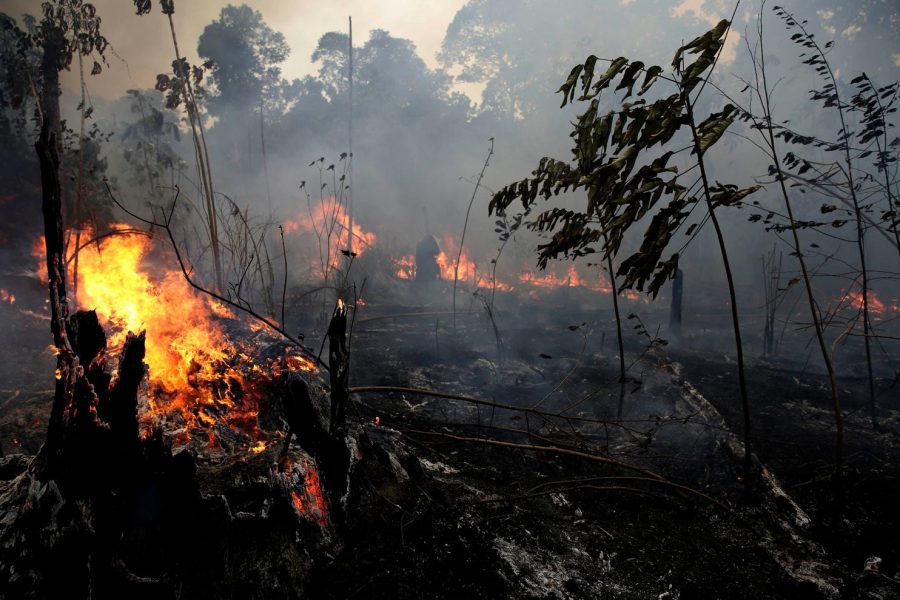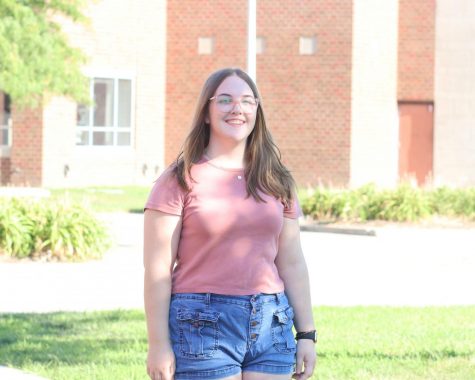The lungs of the Earth are on fire
Amazon Rainforest burns as fires forge
Fires burn and destroy trees in the Brazilian Amazon Rainforest near the road to the Jacundá National Forest. The National Institute for Space Research has reported around 87,000 forest fires in Brazil during the first 8 months of 2019. NASA confirmed this and says this has been the most active year for fires in the Amazon for almost a decade.
September 6, 2019
Above you, over 10,000 different types of trees tower and provide shade. In front of you, more than 2,000 animal species drink from glistening rivers and search for food up in the canopy. Below you, 80,000 plant species thrive in constant rainfall. Jaguars and tree frogs dart around orchids and lilies and passion flowers. Sloths and spider monkeys climb up cacao trees and Brazil nut trees. Pink river dolphins and pancake stingrays glide through the sparkling waters. This is what it’s like to walk through the Amazon Rainforest, the largest tropical rainforest and one of the most biodiverse regions in the world. Soon, it may all be gone.
There are over 40,000 fires currently blazing in the Amazon, according to the National Institute for Space Research, which is a 77% increase from last year. Reports from the World Wildlife Fund suggest that by 2030, half of the Amazon rainforest will be gone. At the current rate, rainforests could completely disappear in the next 100 years, as reported by The Guardian. In a rainforest, these levels of wildfire are not natural. Loggers, ranchers, farmers and other workers burn the trees to make room for cattle raising, soy production and more. Deforestation has also been heightened by Jair Bolsonaro, the Brazilian President, who has been encouraging workers to use Amazonian land for profit since the start of his campaign.
This is no small matter; the Amazon is truly the “Lungs of the Earth”. Though it consumes most of the oxygen it produces, according to World Wildlife Fund, it houses around 90 to 140 billion tons of carbon dioxide which could be released as deforestation continues. Its vast expanse of trees collect water and release it in a massive recycling system that upholds the local wet climate which South American populations depend on for agriculture. The Amazon Rainforest also provides 20% of the earth’s freshwater supply. Furthermore, evidence suggests that the Amazon is playing a large role in curbing climate change and stabilizing global climates and ecosystems.
Aside from being an environmental staple, the Amazon is also home to around one million indigenous people (about 350 tribes in total), according to the World Wildlife Fund. For years they have sustainably used the land and the resources to support themselves, respecting the animals and plants that inhabit the rainforest. Now, they must fight invaders who burn their home, steal their resources, and disrespect their culture and livelihood. It is estimated by National Geographic that although indigenous people make up 5% of the world population, they protect 80% of global biodiversity. Many indigenous people have been forced into the role of activist just to protect their own lives and homes from being destroyed; and they’re being killed for it. International non-profit Global Witness reported that 164 environmental activists were murdered in 2018, and countless more were threatened, attacked, or arrested for opposing the governments and companies who profit off environmental destruction. This adds up to around four deaths per week. Brazil tops the list of environmental activists being murdered since Global Witness started collecting the data in 2012. Indigenous people are heavily impacted as they make up around 30% of the victims.
The work of these environmental activists has not gone without reward. Their efforts have brought international attention to the fires. Under the hashtag #PrayforAmazonia, pictures of burning forests have been taking over and interrupting our usual scrolling through filtered selfies and pictures of Saturday brunches that no one asked for. This attention is extremely necessary given that major media outlets and the global community as a whole ignored the fires for so long. However, it is critical to note that this is a crisis, and a fleeting hashtag and collections of social media posts will not stop it.
The short term solution is to work with local groups to preserve the parts of the forest that aren’t on fire. These groups also work with indigenous tribes in their efforts and hire former miners, loggers and ranchers as conservation workers.
One of the biggest debates within discussions of the Amazon fires has been weighing the long-term solutions of individual actions, such as donating to conservation efforts or going vegan, with collective systemic change.
While decreasing meat consumption and making a switch to sustainable consumption is unequivocally important, we have to recognize that veganism isn’t accessible. Ultimately, we need to work at long term systemic changes to secure the level of change that we desperately need. Until we dismantle the capitalist-colonial systems that demand the destruction of the earth for profit (at the expense of the lives of indigenous people and marginalized groups), then it won’t matter how much water we dump on the forest or how many photos of smoke-filled air and burning trees we post. Furthermore, putting out the literal fire in the Amazon won’t put out the metaphorical fire of ecological destruction that’s destroying the rest of the world. Amazon Rainforest jungle keeper and activist Paul Rosolie said it best when he said that would only “douse the symptoms without treating the disease.”
Over 6,000 kilometers from Omaha, it may seem like the Amazon Rainforest fires are not a threat to us or our school. However, if we do not do our part and deal with this responsibly, then every single person in every corner of the world will suffer. Our water supply will dwindle, temperatures will rise, agriculture will take a hit, and people will continue dying.







